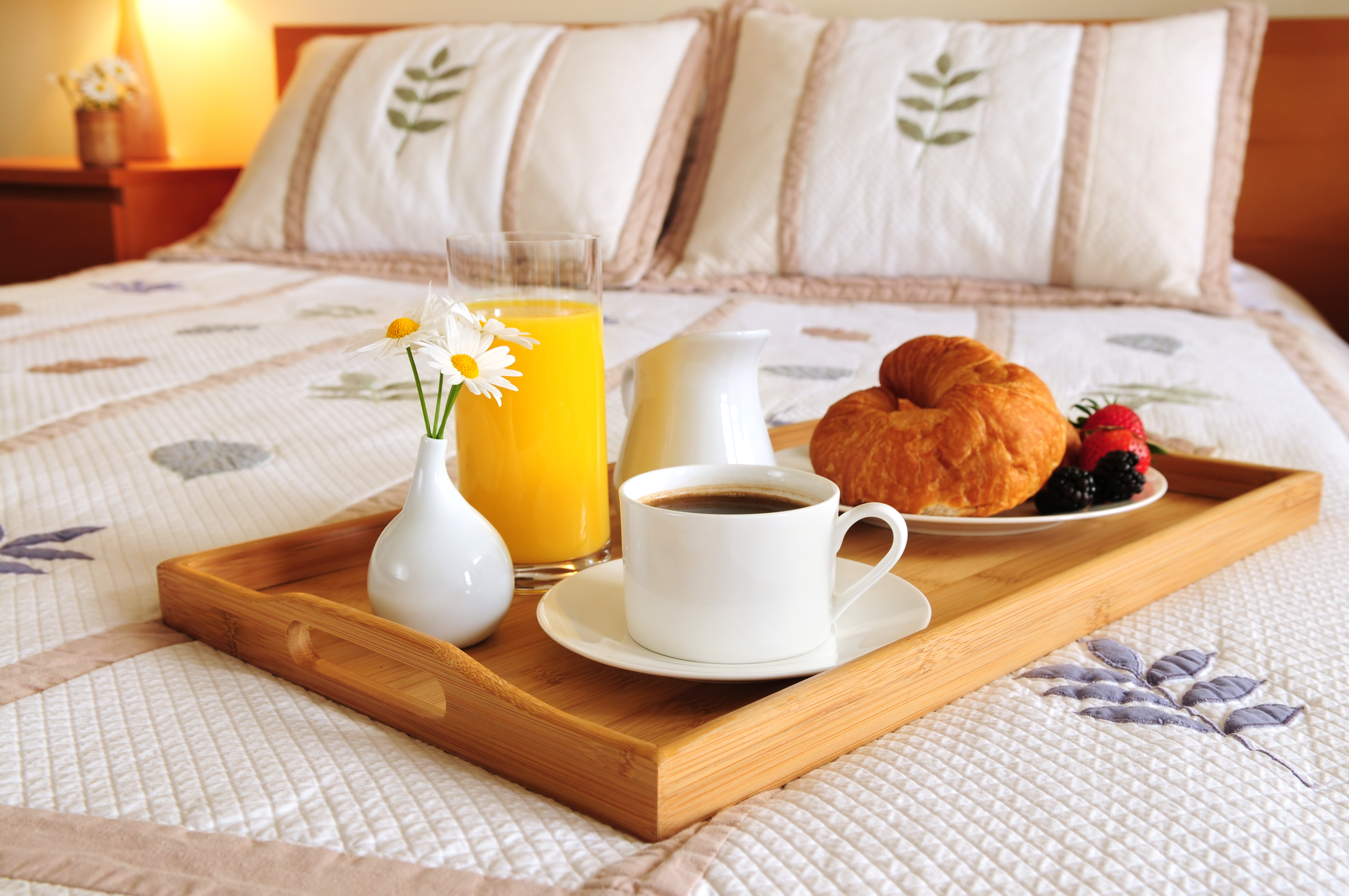A Deep Dive Into How to Start a Bed and Breakfast
Ever thought about renting out your property as a vacation rental? Would you prefer to be more involved than your typical Airbnb host? Would it be even better yet if you could stay on the premises too?
In this case, starting a bed and breakfast can be a great option to explore.
You’ll need to have a combination of administrative as well as interpersonal skills. On top of that, you’ll also need to be flexible and patient. If you boast these skills, it might just be the ideal venture for you. Let’s learn how to start a bed and breakfast.

What’s a Bed and Breakfast?
The concept of a bed and breakfast originated centuries ago in Europe. Back then, it was basically a cozy place where travelers could rest.
Fast-forward hundreds of years and it’s become one of the most popular types of accommodation. From business travelers to out-of-town visitors looking for a romantic weekend, it attracts various types of guests.
It’s typically run as a family business and the rest of the staff often stay onsite. Another key characteristic is that it’s typically set on a small property and has far fewer rooms than your traditional or boutique hotel. This means that the experience is usually more personal, which is one of its unique selling propositions.
While it’s similar to a vacation rental, there are also a few distinct differences between your typical short-term rental and a B&B.
Firstly, the average stay is typically shorter. Many B&B guests choose only to stay overnight.
Secondly, where guests renting a vacation rental often have the entire property to themselves, guests staying at a bed and breakfast will share common areas like a living room or games room. They also usually have more interaction with the owner, other staff, and possibly other guests. B&B guests might have less privacy, but they’re treated to home-cooked breakfast, a service that’s excluded in most vacation rentals, and more personal attention.
Basically, you can think of it as a hybrid business model. It offers the same comfort that guests have come to expect from a boutique hotel or an Airbnb listing, but a more cozy and personalized experience.
What Are the Legal Implications of Starting a Bed and Breakfast?
As you’ll be running a small business, you’ll need to abide by your area’s rules and regulations. These can vary from one area to the next, but will typically include that you apply for a business license, register your business name, and get a tax number.
In addition to the laws governing businesses, you’ll also need to consider local laws like zoning regulations. These types of establishments are typically located in quieter, residential areas, which means that you’ll need to double-check zoning laws carefully before you buy or rent a property.
As you’ll also be serving breakfast, you’ll also need to read up on food safety. There are also local laws that you’ll need to follow if you plan on cooking and serving food.
Not only will you need to understand all the laws and regulations that can apply to running this type of business, but you’ll also need to have all your documents in a row. This includes an adequate insurance policy and permit to serve food (and possibly sell alcohol).
Familiarizing yourself with the rules and regulations is a crucial part of starting a bed and breakfast. It can have a huge impact on the success of your business moving forward. As such, it’s best to hire the services of a tax advisor and attorney specializing in this field. You’ll also be able to find more information about these rules on the website of your local government.
Writing a Bed and Breakfast Business Plan
Just like with any type of business, proper planning is crucial. In addition to the local laws, you’ll also need to research demand and budget carefully.
Creating a business plan will help you to identify potential risks and determine if you’ll be able to generate real profit. If you’ll need to apply for funding, you’ll need to prove this to financial institutions.
Generally, a business plan will include the following sections:
- An executive summary that covers details like the location of your property, target market, and peak season
- Your business goals
- Your value proposition
- The type of management structure
- An operations plan explaining how you’ll run your bed and breakfast business
- A financial plan that covers a profit-and-loss projection for the first year and a five-year growth plan among other things
- An analysis of your competitors as well as ideal guests
- A marketing strategy
Which Costs Are Involved?
First things first, you’ll need a property. This will be your biggest expense.
That said, you don’t necessarily need to buy a property. You can also turn your private home into a bed and breakfast or rent a suitable property. In case of the latter, you’ll need to be up front about your intentions with the property owner. With all three of these scenarios, you’ll also need to check that the property is zoned for this type of use.
You’ll also need to consider renovation costs. As bed and breakfasts are often located in historic homes, you’ll likely need to spend a significant sum in order to get this property guest-ready.
You’ll want to do the math to determine if you’ll have enough cash flow to finance such a project. Remember, you’ll first need to renovate it before you can start to accept bookings and generate an income. Before then, money will only flow out of your business.
Another major expense will be the furniture and other items needed to get set up. You’ll, for example, need kitchen equipment, business supplies (like a laptop and printer), ample linen, signage, smoke detectors, fire alarms, etc. While most of these will be one-off expenses that you’ll only need to worry about much later again, you’ll find that an item like linen will need to be replaced more often.
In addition to these expenses, you’ll also need to budget for ongoing expenses like:
- Insurance premiums
- Website hosting
- Wi-Fi
- Banking fees
- Cleaning supplies
- Food
- Maintenance costs
- Salaries
On the flipside, many of these expenses will be tax-deductible. To deduct them from your gross income, though, you’ll need to remember to keep all the relevant invoices and have a clear bookkeeping system in place.
Must-have Amenities to Include
One of the challenges of setting up a bed and breakfast is finding that balance between luxury and comfort. Guests don’t expect bed and breakfasts to offer the same number of luxury amenities as a hotel, but guest expectations have also evolved. You’ll need to offer more than just a bed and breakfast in the literal sense of the word.
Your main focus will be on furnishing the guest rooms and bathrooms. Here, guests need to find all the amenities that they will need during their stay such as:
- A comfortable bed (ideally king size beds, if space allows it)
- High-quality linen
- An extra blanket
- A bedside table with a reading lamp
- A full-length mirror
- A hair dryer
- A wardrobe with hangers
- Toiletries and soap
- A bath mat
- Toilet paper
- A small garbage can
- Air conditioning
If the guest rooms lead out onto their own private balconies, a small patio set can be a great addition. It’s this type of finishing touch that can make all the difference in the hospitality industry.
Free, fast Wi-Fi has also become an expectation. This is especially important if your target market is mostly business travelers.
Hiring Staff
Running a small bed and breakfast without hiring extra staff is still manageable. However, when you add your fifth guest room, you’ll need additional hands.
Areas that you’ll typically need help with are cleaning, breakfast preparation, and accounting. Hiring employees that will be responsible for cleaning rooms will probably be your first need. You can also try to hire someone who can help you in more than one of these areas.
Just like with any other type of business, you’ll need to create a detailed job description. Not only does it make it easier to attract the right talent, but it can also avoid confusion down the line. You can share this job description on social media platforms like LinkedIn and Facebook and other job websites.
Then, to help you find the right candidate among all the short-listed candidates, use a combination of open-ended questions and practical tests. As your employees will interact with guests, it’s also crucial that you check their references. The last thing you want is to find yourself in a situation where guests accuse your cleaning crew of something like theft, for example.
Setting Your Rates
You’ve done the research. You know which expenses to expect. You have an idea of how many employees you’ll hire. Armed with these numbers, you’re much better equipped to set your room rates.
That said, it’s not as simple as adding all your expenses and simply charging more. You’ll also need to consider factors like:
- The amenities that you offer
- The location of your property
- The average room rate of similar bed and breakfasts in your area
For example, if your bed and breakfast has a swimming pool and is located nearby popular amenities like restaurants, parks, shopping malls, etc., you can afford to charge more. However, it still doesn’t give you free reign. To ensure a constant flow of guests, your nightly rates must be competitively priced.
Marketing Your Bed and Breakfast
Nowadays, most research is done online. This means that if you want to reach new guests and enjoy a good occupancy rate throughout the year, you’ll need to have a solid online presence.
The best way to do that is to:
- List on multiple channels
In addition to creating your own mobile-friendly website, you’ll also want to list your bed and breakfast on third-party sites like Airbnb, Booking.com, and Vrbo. This multichannel approach gives you the best of both worlds. You can accommodate direct bookings which are commission-free, but you’ll also enjoy more exposure by leveraging the website traffic that these popular online travel booking sites attract.
- Post on social media
Your own website remains your biggest digital asset. To help you drive more visitors to your site, you can use social media platforms like Instagram, Facebook, and YouTube.
You can use these channels to share details about your property like special promos as well as upcoming local events and popular nearby attractions. Other post ideas that you can try include:
- Contests
- Travel influencers’ top travel tips
- Cooking videos of your favorite breakfast dishes
- Reviews of top attractions
- User-generated content like guest reviews
Basically, the best marketing strategy focuses on the bed and breakfast as well as the area. After all, the main reason for out-of-town visitors to book a guest room is to explore the surrounding neighborhood. Why not show them what they can look forward to?
In addition to showcasing nearby attractions, you can also work with local businesses and tourism organizations. If you recommend restaurants and tourist attractions to your guests, they might just return the favor.

Five Mistakes to Avoid When Running a Bed and Breakfast Business
Now that you have a better understanding of what you should do, here are five mistakes to avoid. Make no mistake, there are many other mistakes that you’ll make, but these are five of the most common ones.
- Investing in/targeting the wrong market
Location is a deal-breaker.
The area should have enough demand (ideally, throughout the year). It should also not have too many regulations or other established bed and breakfasts that could make running a successful bed and breakfast harder than it has to be.
Not only should you research your real estate market, but also your target market. Another common misconception is that you need to market to everyone.
For example, if your property is located close to a convention center or central business district, targeting business travelers will make more sense. On the other hand, if it’s situated in a rural area and offers features like a swimming pool, targeting couples planning the ideal romantic getaway will drive more money.
- Inadequate meal planning
Wasted food can cut into your profit margin. To minimize food wastage, request that guests share any dietary requirements or preferences. After all, your guests booked a room at your bed and breakfast because it’s this type of personal attention that they want.
If wasted food is a recurring problem, it might be time to reevaluate the size of your breakfast portions. It could be that while guests love your scrambled eggs, the portion is simply too generous.
- Neglecting research and prep
Whether it’s the desire to start making money or excitement to meet new guests, many bed and breakfast owners fall into the trap of opening before they’re entirely ready. If your first guest reviews are mediocre, it will be more challenging to attract guests moving forward.
So, take your time. Do your due diligence. Add that fresh coat of paint and watch it dry.
- Lacking a unique selling proposition
Unlike hotels, bed and breakfasts are expected to offer something unique and more personal. That said, not only will you need to find a way to differentiate yourself from other types of accommodation like boutique hotels and short-term rentals, but also other bed and breakfasts in your area. Whether that’s by cooking breakfast using only locally sourced ingredients or decorating guest rooms according to a theme, you’ll need to think creatively to be successful in the hospitality business.
- Doing everything manually (or too much)
There are numerous tasks involved in hosting guests. Not only will you need to hire staff or outsource tasks like laundry, but you’ll also need to invest in software like channel managers or property management systems. In fact, if you’ll be listing on multiple channels (which is recommended), a channel manager will be a must to eliminate double-bookings.
For example, a tool like iGMS is more than just a channel manager. In addition to calendar synchronization, it can also help with various other routine tasks involved in running a bed and breakfast business like:
- Managing several accounts and listings on the leading rental platforms via a single interface can be achieved with the Channel Manager.
- Streamlining guest communication with the help of message templates is made easy with Automated Messaging.
- Receiving payouts and creating invoices by connecting your Stripe account to iGMS is facilitated by Payment Processing.
- Encouraging guests to review their stay by automatically sending reminders can be set up using Airbnb Automation.
- Managing direct bookings using a direct booking management toolkit is possible with the Direct Booking Management Toolset.
It also includes a website builder. As mentioned earlier, your own business website is a must. With its website builder feature, you can have a website up in running in a few minutes, eliminating the need to hire a web designer too.
Sure, there are additional fees involved in using software. However, the time that it will save you will far outweigh the minimal subscription. Plus, it can also help to improve the way guests view your business.
There’s a growing expectation among guests that businesses operating in the hospitality industry should embrace technology. By automating more routine tasks, you’ll also have more time to personalize the guest experience — the reason why guests prefer a bed and breakfast over a hotel stay.
While guests expect more personal attention, guard against offering too much. At the end of the day, you’re still running a business. Offering too many extra free services can hurt your profit margin. Instead, you can explore the idea of upselling. It’s commonly implemented by hotels and can be a great way to drive incremental revenue.
It should also remain worth your time. If you find yourself without having any free time at all, it’s time to rethink the way you manage your new business.






![Your Monthly iGMS Roundup [February 2020]](/content/images/size/w600/wordpress/2020/02/igms-roundup-feb-2020-cover.png)

